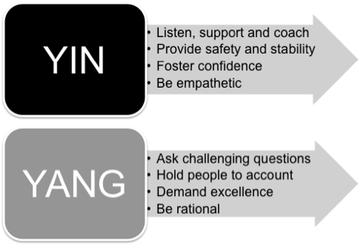In order to provide your team with the best conditions for growth and enable them to generate optimal results on the project, you must do two things; First you must demand a great outcome, and second, you must enable your team to generate that outcome. You have to ask challenging questions, set high standards and expect the best quality on the one hand, and on the other you have to provide the team with all the support it needs to deliver.
The ability to fully support and enable your team to grow and at the same time challenge and stretch it, is a skill that can be learnt and honed over time. Let us look at how you can do that by using the concepts of yin and yang.
Yin symbolizes the feminine elements such as listening, supporting, coaching and maintaining stability. These are characteristics that are hugely important when establishing a high-performing team, especially in the early days when people don’t yet trust their own abilities or roles within the team. Project leaders use the supportive yin element to build the team’s confidence and develop skills that are lacking. They encourage collaboration and provide a safe environment for team members to work together and come up with their own solutions.
Supportive yin-leaders have a deep respect for people and want to understand what drives and motivates each person. They often spend one-on-one time with team members, assisting them to grow and develop. They are good at praising people for a job well done and will often ask what type of help the individual needs. Yin leadership is enabling and is concerned with making it possible for others to flourish, lead and contribute.
Yang, on the other hand, symbolizes the masculine element, which is challenging, demanding and factual. This side of leadership sets a high standard and expects the team to deliver to it. Yang leaders have a strong sense of direction. They are action-oriented and results-driven. They ask challenging questions, hold people to account and may come across as forceful. They are assertive, push the team to deliver to the best of its ability and expect nothing but excellence.
It is the yang element that pushes the team to continuously improve and innovate, and the yin element that steps back and enables the team to do so. We could say that yin is a predominant heart-based approach, whereas yang is a predominant rational or head-based approach.
Project leaders use ample amounts of both yin and yang
Consider the below diagram. It shows that project leadership encompasses a high degree of yin as well as yang. Team members need both elements from their manager in order to perform and thrive.
Imbalances in yin and yang create a lopsided leadership style
When managers have a preference for either yin or yang, they can develop a lopsided or dysfunctional style. Either the yin or the yang element has grown to dominate and stunt the other. Leaders who have a lot of yang, and very little yin, tend to create stress around them. They demand a lot but don’t give the team the security, confidence and space it needs to perform. On the other hand, when leaders only use yin, they run the risk of being too soft and nice and supporting people without looking for a return.
Teams need the dynamic tension of both yin and yang and leaders need to reconcile the two. Leadership is not about “either/or” but about “and”. We must be enabling and forceful; forgiving and demanding; flexible and tough; supportive and challenging.
What is your own style?
Are you aware of how much yin and yang you use to lead and manage people? Why not ask the members of your team how they perceive you? Print off the above matrix and ask each person where they would place you. What you may find is that their perception of how challenging and supportive you are is very different from what you imagined. It will increase your self-awareness and open up a conversation that will improve trust between you and your team member.
To read more about how to access your supportive side as well as your challenging side, get hold of The Power of Project Leadership (2nd edition). |











 RSS Feed
RSS Feed